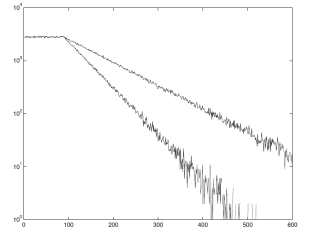This is an old revision of the document!
Artefacts in Antibunching Histograms - Slow Decay
In this show-case the external preconditions are:
- detectors: perkin elmer SPCMAQR14
- 700 nm SP filter in front of one of the APDs
- sample: diamond nanocrystals (100 nm), we are measuring the antibunching of the NV centers emission
- laser wavelength: 532 nm, cw
- T3R Measurement with PicoHarp Software
A.: The decay can be caused by blinking of the nanodiamonds.
A decay caused by correlation statistics
This decay is caused by correlation statistics. This happens because you correlate the first arriving photon against a photon at the longer time, which will be an increasingly unlikely event because the earliest stop photons always win and the experiment restarts.
I attached a simulation.
The timescale is in ns. The plateau is the dead time. The decay slope depends on the count rate.
The way to avoid this is to calculate the total correlation after T2 MODE MEASUREMENT. This is not a start-stop correlation but the correlation of every photon against every photon.
It can be done using the SymPhoTime Software (http://www.picoquant.com/products/sw_mt/sw_mt.htm).

